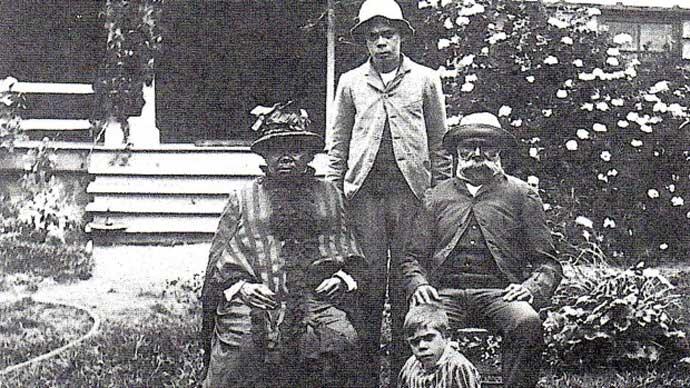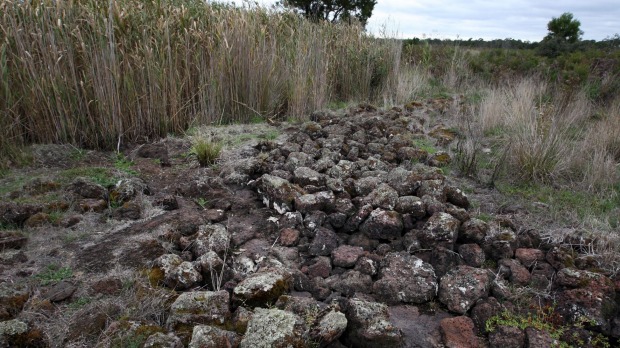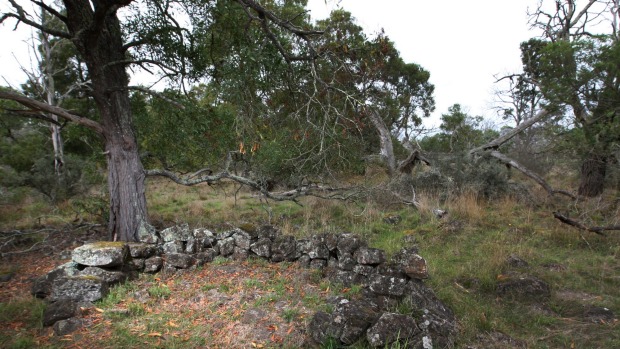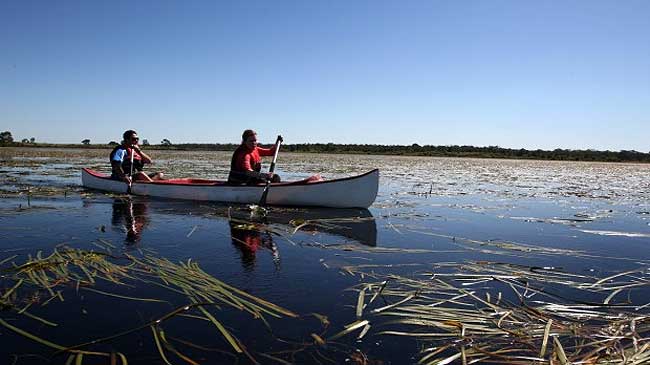Kitty Wallaby: Linked between the Dreamtime and the grim world of 1800's
Kitty Wallaby's life was linked with the Dreamtime, and her people, the Gunditjmara in Western Victoria, built sprawling villages of stone houses and an aquaculture system that pre-dated Egypt's pyramids and Stonehenge.
When Kitty told the invading pastoralists that is was her country, they were not interested in listening or understanding.

Rare picture of Kitty and Billy Wallaby and their kids. From Jan Critchett's book Untold Stories.
Photo: Melbourne University Press
Having suffered the misfortune of being born in 1840, Kitty Wallaby remained a woman of pride
Tony Wright 6 June 2015
My grandfather, a boy in the late 1800s, often came across her camped regally on the bank of the Fitzroy River below his family's farmhouse near a place called Tyrendarra on the windswept south-west coast of Victoria.
He and his brothers tried to sneak up on her with intention to tease, for she smoked a clay pipe. They'd never seen a woman smoking a pipe. She always heard their approach and buried her pipe in the ashes of her campfire.

An eel canal at Kurtonitj north of Tyrendarra. (Photo: Leanne Pickett)
Kitty Wallaby was a proud woman. She had survived a lot worse than cheeky boys.
Once, the boys were sent by their mother to offer her some food.
She refused, declaring she knew how to find plenty of her own, thank you. She captured freshwater crayfish with her toes and caught fish with net and line.
"This is my country, you know," she once told my grandfather. He was affronted and told her his family owned the land. He'd been born there.
"No," she insisted. "It's my country, but you're welcome to stay."
My grandfather never forgot it, chuckling at the memory into old age.
He should have listened harder.

An original stonehouse site at Kurtonitj north of Tyrendarra.
(Photo: Leanne Pickett)
Kitty Wallaby's life linked the Dreamtime with what became, for her and her people, a much grimmer modern Australia.
Her people, the Gunditjmara, had built on their country something unique: sprawling villages of stone houses and an aquaculture system that pre-dated Egypt's pyramids by at least 4000 years and even Stonehenge by 1400 years.
And though in her late years she followed the seasons along a river in search of food, her people had never needed to be nomadic.
Kitty Wallaby could not have imagined it, but the entire world may yet recognise the world she had lost.
The Commonwealth government is currently studying a proposal backed by the Victorian government to begin the process of recognising Kitty's country – Budj Bim – for listing as a UNESCO World Heritage site.
The proposal for such a status follows years of archaeological work, painstaking documentation and plain hard work by the traditional owners, the Guntitj Mirring Aboriginal Corporation, that identifies the area as a marvel of prehistoric engineering: the site of an Aboriginal settlement so large as to be almost suburban, its houses constructed of stone walls, and an ingenious system, at least 6600 years old, of trapping eels and fish.
It would be the 20th place of such international significance to be recognised in Australia, along with such jewels as the Great Barrier Reef, ancient rainforests, Kakadu, the Tasmanian wilderness, convict settlements, marine wonderlands, the Sydney Opera House and Melbourne's Royal Exhibition Building.
Kitty's Gunditjmara people always called their country Budj Bim.
The name means "little (or high) head", and refers to the old volcano near Macarthur that is known as Mt Eccles. Seen from a distance, the mountain rears above the forest as if it were the forehead of a man.
The Budj Bim landscape, however, is vastly more than a volcano.
When it erupted some 30,000 years ago, Budj Bim spewed out a river of molten lava that flowed west before turning south to the coast, continuing for 15 kilometres into what now are the waters of Portland Bay between Port Fairy and Portland.
As it cooled, forming a landscape of rough stony rises, the lava flow dammed water from the north, forming Lake Condah, and released a stream known as Darlots Creek, which joins the Fitzroy River at Tyrendarra before flowing into the sea.
It is up these waterways that millions of eels migrate each year.
Some thousands of years ago, the Gunditjmara engineered an ingenious system of using stones from the lava field to form a system of weirs that trapped eels and other fish, providing them with a year-round supply of fresh food, even in drought. The eels were smoked in hollow trees. There was enough for trading with other indigenous peoples. The Gunditjmara became settlers, and defended their rocky citadel fiercely.
Kitty Wallaby was born Gunditjmara.
She suffered, however, the misfortune of being born in 1840, just as white squatters with sheep and guns began to spread across the edges of her country.
Her journey from birth to womanhood and marriage to a fellow named Billy Wallaby, born in 1834, took place in the shadow of a war. The Gunditjmara took squatters' sheep and the squatters and troopers took Gunditjmara land and lives.
Kitty and Billy lived through it all, watching their people being destroyed, until, starving, the remnants of the Gunditjamara were swept into a mission station set up at Lake Condah. They were on their own land, but it was no longer theirs and they were treated as children, the old ways and language forbidden, handed rations only if they "behaved".
Kitty and Billy Wallaby rebelled and joined others who shifted regularly to a nearby camp known as Dunmore, which was not sanctioned.
Billy and Kitty Wallaby, fumed the mission boss, the Rev Heinrich Stahle, in 1899, "have always been at the bottom of the mischief with regards to the blacks who made for Dunmore whenever they became unruly on the station".
Undeterred, Kitty regularly struck out on her own, catching her own fish down the river. She outlived Billy by 10 years and died, aged 70, in 1910, leaving only her words: "This is my country".
And now, it could become Australia's 20th World Heritage site. She'd never believe it.
Budj Bim National Heritage Landscape - Mt Eccles Lake Condah Area, Mt Eccles Rd, Macarthur, VIC, Australia

Lake Condah in south-west Victoria. (Photo: Damian White)
Tony Wright 'The Age' 5 June 2015
An ancient Aboriginal settlement on a volcanic lava flow in south-west Victoria – the setting for a bloody war between Indigenous people and white settlers in the mid-19th century – appears likely to become Australia's latest UNESCO World Heritage site.
Federal Environment Minister Greg Hunt has told Fairfax that he believes the Budj Bim landscape – stony rises from Mt Eccles near Macarthur to a prehistoric aquaculture system on Lake Condah and south to Tyrendarra wetlands – was an outstanding site that had the potential to achieve World Heritage status.
He has invited the Victorian government to complete an independently audited assessment to prove compliance with world heritage values.
If that showed there were "recognised outstanding universal values, then I would be delighted to propose this as a tentative item for listing by the World Heritage Committee", he said.
The Victorian Premier, Daniel Andrews, has written to Mr Hunt stating the Victorian government's full support for listing Budj Bim, and has forwarded a peer-reviewed study by leading scientists and archaeologists that finds the landscape is of international significance and that the criteria for listing is fully justified.
Budj Bim – the Indigenous name of Mt Eccles which produced the lava flow that was settled by the Gunditjmara Indigenous people thousands of years ago – is already on the Australian National Heritage Register.
World Heritage listing would elevate it to the status of the Great Barrier Reef, one of the 19 Australian sites currently receiving international protection.
The Gunditjmara are considered unique in Australia. They lived in large villages constructed of stone huts and harvested eels and fish in a sophisticated network of weirs and traps, dated to at least 6600 years ago, that meant they had no need of a nomadic lifestyle.
The Gunditj Mirring Traditional Owners Aboriginal Corporation, backed by teams of archaeologists, historians and independent heritage experts, having been gathering evidence for a decade to support the nomination for UNESCO World Heritage listing.
By Tony Wright The Age June 6, 2015

